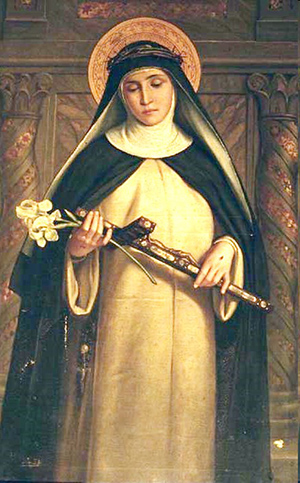Saint Catherine of Siena, 1347-1380
Feast Day April 29

We celebrate Catherine of Siena as an international political figure, a feminist hero, and a doctor of the church. To get a more accurate view of Catherine, imagine a scruffy, not-so-respectable version of Mother Teresa. Catherine was not a nun, however, but a member of the Dominican Third Order. Thus she followed the life pattern of the Friars Preachers as a layperson.

Think of her as an old-fashioned Italian matriarch, pious but sharp-tongued, who scandalized as many people as she influenced. Picture this short, frail lady, garbed in worn, rough clothes, in some of her typical daily activities, which included:
- Managing a large household of followers, all of whom called her “Mama.”
- Living in poverty and begging with her disciples for everything they needed.
- Fasting severely but always seeing that her friends were well fed. Cooking food, baking bread, and sometimes praying for a miraculous multiplication or delivery of food.
- Praying for many hours at a time, at times seeming to become weightless when deep in prayer. People claim to have seen her floating a few inches off the ground.
- Reading the thoughts and knowing the temptations of her associates, even at long distances. She saw people’s secret sins and confronted these people, urging them to repent. She touched hearts so effectively that the Friars Preachers had to designate three priests to handle the confessions of her penitents.
- Interceding fiercely for hardened criminals in Siena’s jails. Even blasphemous prisoners embraced
the gospel when she visited them. - Caring for the sick. God healed plague victims when she prayed for them or touched them.
- Finally, offering advice to popes and princes. However, she was not so much an international politician as she was a spiritual director, and her venue was not the entire world but a small quadrant in northern Italy. The issue that concerned her most was not governmental but ecclesiastical. Catherine’s passion was for the unity of the church.
In 1376, Catherine worked to repair a breach between Pope Gregory XI and a league of northern Italian cities led by Florence. Since 1305, the papacy had been a cause of contention between the French and the Italians. Turmoil in Rome and conflict with the emperor had forced the popes to retreat to Avignon in southern France. Catherine shared the popular Italian desire to restore the papacy to Rome. Pope Gregory XI was willing to make the move, but his powerful French advisers resisted.
Catherine conducted a campaign of letters to all sides and offered to mediate directly. She wrote Pope Gregory XI six times, exhorting him to return to Rome. The pope said that Catherine addressed him with an “intolerably dictatorial tone, a little sweetened with expressions of her perfect Christian deference.” Encouraged by the Florentines, she went to Avignon on a peacemaking mission.
Apparently the pope had made a secret vow to move back to Rome, and this vow was revealed to Catherine. When she met the pope at Avignon, she didn’t hesitate to use that inspired bit of information to pressure him. “Keep the promise you have made,” she urged, to his great surprise. Not long after this encounter, Gregory XI returned the papacy to Rome. Catherine’s efforts to reconcile the pope and the Italian cities finally succeeded during the reign of Urban VI, Gregory’s successor.
More than anything, a dual passion for God and for the welfare of others consumed Catherine. As she pursued these passions, miracles happened.
Once, Catherine prayed for two condemned prisoners, who were then profoundly touched by God. Here’s how it happened: Siena’s magistrates had sentenced two hardened criminals to a brutal public death. They were driven about town in a cart while executioners tore at their bodies with red-hot pincers. The condemned men showed no trace of remorse for their crimes and roared curses and blasphemies at the people who lined the streets. They had refused to speak with the priests who had offered to prepare them for death.
Providentially for the prisoners, Catherine happened that day to be visiting a friend who lived on one of the roads the cart had to travel. “Mama, look at this horrible sight,” said the woman as the tumultuous parade went by. While Catherine stood at the window observing the terrible scene, she was moved by compassion. In her mind’s eye, she saw a mob of demons ready to punish the condemned men even more sadistically in hell.
Immediately she began to pray for the two unfortunates. “My most merciful Lord,” she said with her characteristic frankness, “why do you show such contempt for your own creatures? Why are you letting them suffer such torture now? And even more vicious torture by these hellish spirits?” Catherine never beat around the bush, even in conversations with God.
To the amazement of all, both criminals suddenly stopped shouting curses and cried out for a priest. They wept and confessed their sins to him. The crucified Christ, they claimed, had appeared to them urging repentance and offering forgiveness. They told the crowd that they expected to be with Christ in heaven, and then they submitted peacefully to their execution. This miraculous turn of events mystified the whole town, but Catherine’s close friends knew that she had intervened in some way. For many days after the dramatic conversions, she was heard to say, “Thanks, Lord, for saving them from a second prison.”
St. Raymond of Capua, Catherine's spiritual director and biographer, assisted her in another notable conversion. A celebrated rascal named Nanni di Ser Vanni specialized in stirring up private feuds. His plots often led to violent outbursts, and once one of his schemes resulted in a murder. No one could pin any charges on Nanni, but the whole town was wary of him. Raymond said that Nanni was so slippery that he would trick God if he could.
Catherine wanted a chance to persuade Nanni to change his ways, but he avoided her, said Raymond, as “the snake avoids the charmer.” One of her disciples, however, convinced Nanni to visit her and to listen to what she had to say. Nanni thought he would hear her out and then go about his business. He had no idea what he was in for.
Raymond was present when Nanni met Catherine. She greeted him politely, offered him a seat, and asked why he had come.
“I came,” he said, “because I promised a mutual friend that I would. He asked me to tell you the truth about my affairs, and I will. But don’t imagine that you can make me stop.”
Then Nanni candidly admitted that he was behind several murderous plots presently seething in Siena. In her typical blend of sweetness and sharpness, Catherine warned him that his soul was in mortal danger, but Nanni adamantly refused to change his behavior.
When Catherine realized that he had turned a deaf ear, she began to pray quietly and then immediately drifted into an ecstasy. Raymond covered for her and picked up the conversation. Shortly, Nanni found himself talking about his machinations. He described one feud in detail and expressed his willingness to let Raymond quell that disturbance.
Then an extraordinary thing happened. Nanni made a move to leave, but remorse overwhelmed him. “My God,” he said, “how contented I feel in my soul from having said I shall make peace! Lord God, what is this power that draws me? I can’t go and I can’t say no.” After that, he promised to do anything Catherine directed him to do to set things right.
Catherine awakened and said, “I spoke to you, and you would not listen, so I spoke to God and he got your attention.” Then she gently urged Nanni to make peace with God, which he did on the spot. Over the next few weeks, she helped him reconcile with all his enemies, and from that time on Nanni lived an upright life. The scoundrel had experienced a complete personal transformation. Later on, to express his gratitude, he deeded to Catherine a castle near Siena, which she turned into a convent.
When the plague struck Siena, Catherine and her friends courageously tended the sick. The disease eventually struck Matteo, the rector of the city’s hospital and a close friend of Catherine. When she got the news, she hurried off to see him. She was hot with anger at the plague, and even before she reached his bed she began shouting from a distance: “Get up, Matteo, get up! This is not time for lying in a soft bed!” At this command, Matteo’s fever, swelling, and pain disappeared.
Catherine slipped away to avoid attracting attention. Just then Raymond—unaware of the miracle—approached and begged her to pray for Matteo’s recovery.
“What?” exclaimed Catherine, pretending to be offended. “Do you think I am God that I can deliver someone from death?”
“Don’t give me that!” said Raymond. “I know that Jesus does whatever you ask him to.”
Catherine smiled mischievously. “Cheer up,” she said. “He won’t die this time.”
A short time later, Raymond shared a hearty celebration meal with Matteo, who a few hours before could barely open his mouth.
One day in Catherine’s neighborhood, a balcony collapsed, hurtling a woman to the ground. The victim lived near Catherine, and they were friends. Falling debris had so badly cut and bruised the woman that she could not move. Catherine visited her injured friend and tried to comfort her. In a soothing gesture, she touched the woman, and the pain immediately left that spot. The woman begged Catherine to touch another place that hurt. There, too, the pain vanished. So they kept it up—the woman requesting that Catherine touch injured places until all the pain was gone. The woman had recovered completely. “Catherine,” she told everyone, “has cured me by touching me.”
Once, on a visit to Pisa, Catherine found herself in a seriously weakened condition. Raymond of Capua and other friends sought a remedy to strengthen her. They searched for some vernaccia, a wine with healing properties. Vernaccia was supposed to bring relief when applied to a sick person’s temples and wrists. Catherine’s friends asked a neighbor who always stocked vernaccia to give them a decanter. “I would gladly give you the barrel if I had it,” he said, “but it has been empty for three months.” For emphasis, he pulled the spigot from the barrel and then stared in amazement as wine gushed forth. So Catherine’s friends miraculously obtained medicine for her.
To Catherine’s great embarrassment, news of the miracle spread throughout Pisa. She was back on her feet in a few days, and people greeted her excitedly. “Well, what do you know,” someone teased. “You don’t drink wine but you can fill an empty cask with it!”
The hubbub displeased Catherine. “O Lord,” she prayed with near-irreverent familiarity, “why have you willed to inflict me with the pain of this mockery? Who asked you for the wine, anyway? For a long time I’ve deprived my body of wine, but now wine is making a joke of me. By your infinite mercy, have pity on me! Do something and put an end to this chatter.”
The wine turned as sour as vinegar and was no longer potable. The owner of the miracle barrel and those who came to sample the wine stopped talking about it. Catherine was delighted.
I liked Catherine of Siena when I knew her superficially as an ambassador who straightened out affairs of church and state. I admire her more now that I have become better acquainted with her. She was a sweet curmudgeon, like several of my Italian aunts. The beatitude says, “Blessed are the peacemakers, for they shall be called children of God.” That text sums up Catherine’s life perfectly.
from Mystics and Miracles
Image credit: St Catherine of Siena by Neroccio di Bartolomeo de' Landi, 1475. Public Domain via Wikimedia.

